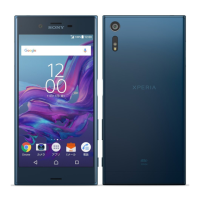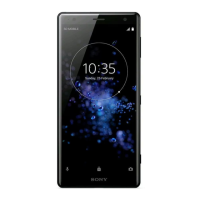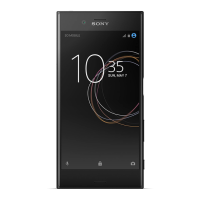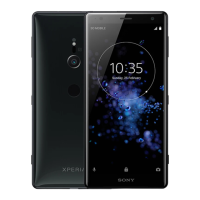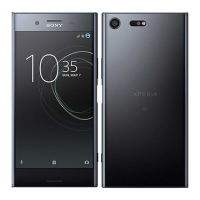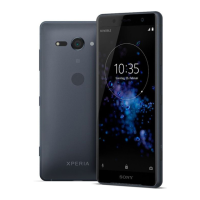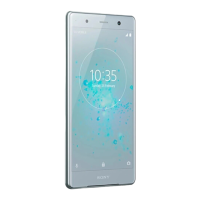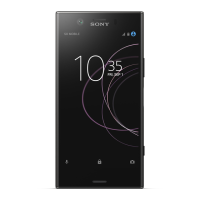
Do you have a question about the Sony Xperia XZ1 Compact G8441 and is the answer not in the manual?
| Display Size | 4.6 inches |
|---|---|
| Resolution | 720 x 1280 pixels |
| Display Type | IPS LCD |
| Display Protection | Corning Gorilla Glass 5 |
| Processor | Qualcomm MSM8998 Snapdragon 835 |
| RAM | 4 GB |
| Internal Storage | 32 GB |
| Rear Camera | 19 MP |
| Front Camera | 8 MP |
| Front Camera Video | 1080p@30fps |
| Battery Capacity | 2700 mAh |
| Battery Type | Non-removable Li-Ion |
| Charging | Quick Charge 3.0 |
| Operating System | Android 8.0 (Oreo), upgradable to Android 9.0 (Pie) |
| Weight | 140 g |
| Network Technology | GSM / HSPA / LTE |
| Launch Date | August 2017 |
| SIM | Single SIM (Nano-SIM) or Hybrid Dual SIM (Nano-SIM, dual stand-by) |
| Water Resistance | IP68 dust/water resistant (up to 1.5m for 30 mins) |
| Loudspeaker | Yes, with stereo speakers |
| 3.5mm jack | Yes |
| WLAN | Wi-Fi 802.11 a/b/g/n/ac, dual-band, Wi-Fi Direct, DLNA, hotspot |
| Bluetooth | 5.0, A2DP, aptX HD, LE |
| GPS | Yes, with A-GPS, GLONASS, BDS, GALILEO |
| NFC | Yes |
| USB | USB Type-C 3.1 |
| Sensors | Fingerprint (side-mounted), accelerometer, gyro, proximity, barometer, compass, color spectrum |
| Colors | Black, White Silver, Horizon Blue, Twilight Pink |
| Rear Camera Features | Predictive phase detection and laser autofocus, LED flash |
| Rear Camera Video | 4K@30fps, 1080p@60fps, 720p@960fps |
| Front Camera Features | 1/4", 1.12µm |
| Dimensions | 129 x 64 x 9.3 mm |
| Build | Glass front (Gorilla Glass 5), plastic back, plastic frame |
Introductory overview of the user guide.
Steps to charge and turn on the device for initial setup.
Explains the benefits and necessity of a Google account.
Setting up PIN, password, pattern, or fingerprint for security.
Importance of Google account for device services and security.
Service to remotely locate, lock, or erase a lost device.
Securing the SIM card with a PIN.
Locating the unique IMEI number for device identification.
Using Find My Device service to manage lost or stolen devices.
How location services determine device position using Wi-Fi and GPS.
Tips to enhance GPS signal reception for accurate location.
Using Smart Lock for automatic device unlocking.
Managing fingerprints for device unlock and authentication.
Basic operations and interactions with the touchscreen.
Touchscreen gestures for zooming and scrolling.
How to turn the device screen on and off, and adjust idle time.
The main interface for using the device, similar to a desktop.
Customizing grid size and icon size on the Homescreen.
Displays pre-installed and downloaded applications.
Using app icons for quick actions and app info.
Customizing the Home and Lock screen with wallpapers and themes.
Capturing still images of the device screen.
Information on how notifications appear and are managed.
Settings to control how notifications appear on the lock screen.
Explains various status icons for signal, Wi-Fi, and battery.
Preventing specific apps from sending notifications.
Viewing two applications simultaneously on the screen.
Small applications for the Homescreen, functioning as shortcuts.
Managing applications and keeping the Home screen tidy.
Instructions and tips for charging the device battery.
Managing power consumption and battery life.
Power saving mode restricting features to extend battery life.
How to update device software for functionality and bug fixes.
Installing software updates directly on the device.
Tools and applications for device management via computer.
Transferring and managing device files via computer.
Understanding internal storage and memory card usage.
Tips to optimize device performance by managing memory.
Methods for backing up and restoring device data.
Using Google Backup to back up data to a server.
Installing apps from the official Google Play store.
Enabling and installing apps from outside Google Play.
Using Google Chrome to access websites.
Connecting to and managing Wi-Fi networks.
Configuring Wi-Fi to turn on automatically or receive notifications.
Sharing device's data via USB, Wi-Fi hotspot, or Bluetooth.
Tracking and managing cellular and Wi-Fi data usage.
Choosing network modes and activating automatic network selection.
Syncing contacts, email, and calendar with online accounts.
Setting up and syncing corporate email and calendar data.
How to open and navigate the device settings menu.
Adjusting device volume, vibration, and sound settings.
Setting ringtones, notification sounds, and other audio alerts.
Silencing sounds and vibrations for undisturbed periods.
Adjusting screen behavior, brightness, size, and quality.
Locking the screen to a single application.
Managing app permissions and configurations.
Controlling automatic updates for apps from Play Store and What's New.
Resetting app preferences, data, cache, or default settings.
Changing the device language and text input language.
Setting the device date, time, and time zone.
Optimizing audio quality with equalizer and surround sound.
Enabling and managing a temporary guest account.
How to switch between different user accounts on the device.
Using the device's virtual keyboards for text input.
Selecting, cutting, copying, and pasting text.
Saving and reusing personal information for forms.
Dialing numbers manually or using smart dial for calls.
Answering or rejecting incoming calls.
Rejecting calls by sending automatic text messages.
Handling calls by gestures like bringing the device to your ear.
Directing incoming calls to another number or device.
Preventing specific numbers from calling or messaging.
Creating, editing, and personalizing contacts.
Organizing contacts into groups or labels.
Moving contacts from old devices using various methods.
Exporting contacts to memory card, SIM card, or internal storage.
Viewing message conversations and composing new messages.
Configuring message notification settings and delivery reports.
Copying music files from a computer to the device.
Using the Music application to play audio files.
Overview of camera interface and basic controls.
Functions of the shutter button in different camera modes.
Selecting different modes like Manual for photos.
Using the self-timer for delayed photo capture.
Adjusting settings for optimal light, color, and exposure.
Controlling shutter speed for motion blur effects.
Adjusting camera sensitivity to light.
Adjusting color balance for different lighting conditions.
Adjusting exposure metering for specific parts of a photo.
Adjusting focus area and distance for sharper images.
Tips for photographing people and using Smile Shutter.
Guidance on photographing people and taking selfies.
Tips for capturing moving subjects with Predictive Capture and object tracking.
Utilizing apps like AR effect and Creative effect for photo enhancement.
Capturing wide-angle panoramic photos.
Recording background sound with a photo.
Recording videos with slow-motion effects.
Understanding how resolution affects memory usage and storage.
Details on different video resolutions and frame rates.
Running tests to identify camera issues.
Saving photo/video location data using GPS.
Configuring photo previews after capture.
Customizing volume key functions like zoom or shutter.
Browsing and viewing photos/videos in the Album app.
Navigating the main menu of the Album application.
Sharing, managing, and editing photos/videos.
Hiding photos/videos in a secure folder.
Showing device screen on a TV wirelessly via Wi-Fi Direct.
Connecting accessories like storage devices or headphones via USB.
Using NFC for data sharing and tag scanning.
Reading information from NFC tags.
Connecting to Bluetooth devices for file transfer and accessories.
Naming, pairing, connecting, and unpairing Bluetooth devices.
Sending and receiving files via Bluetooth.
Using Google app for search and personalized updates.
Managing payment services and making payments using NFC.
Customizing device settings for specific situations.
Managing time schedule and calendar events.
Setting, managing, and customizing alarms.
Zooming in on screen areas for better visibility.
Adjusting the default text size on the device.
Changing the size of all screen elements.
Adjusting screen colors for color blindness.
Screen reader service for visually impaired users.
Playing audio from both channels simultaneously.
Interacting with the device using external switches.
Accessing device info, troubleshooting, and support.
Forcing restart, factory reset, and software repair procedures.
Using Xperia Companion to fix software issues.
Information on warranty, safety, and usage.
Legal notices and trademark information.


